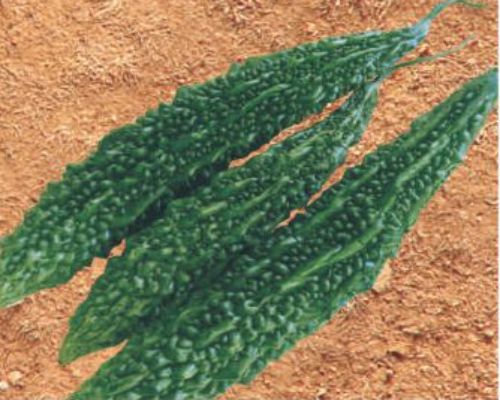
BITTER GOURD ASMITA (SYNGENTA)
|
AGRONOMY |
|
|
Suitability of the variety for the Area Agro Climatic Zone |
All India |
|
Selection of the field/land preparation practices |
The field should be well prepared free from weeds and a well a drainage facility. 1-2 deep plowing, Soil should be exposed to sunlight, 3 to 4 rounds of harrows to reach fine tilt. Before the final harrow, apply 8 - 10 MT well-decomposed FYM/acre along with 250 gm Trichoderma for controlling soil-born fungus. |
|
Seed Treatment-rate of timing/ chemical |
Seeds are treated with Carbendazim 2g + Thiram 2 g per Kg of seeds. |
|
Sowing Time |
Summer, Rabi, Kharif |
|
Seed Rate/ Sowing method- line sowing with row to row and plant to plant distance/ direct sowing |
Seed Rate: 600-700 g per acre. Sowing: Direct in the main field. Spacing: Row to Row and Plant to Plant - 120 x 60 cm |
|
Fertilizer dose with timing |
Total N:P: K requirement @ 75:50:50 kg per acre.
Basal Dose: Apply 50% N and 100% P, K as basal dose during final land preparation.
Top Dressing: 25% N at 30 days after sowing and 25% N at 50 days after sowing |
|
Weed Control- Chemicals with doses and timing |
Timely weed removal is very important, need-based hand weeding can be done to ensure a healthy crop |
|
Diseases & Pest control- Chemicals with doses and timing |
For effective crop, control applies fungicide as per recommendation from the Department of Agriculture (plant protection) to control Damping-off, Downey Mildew, Powdery Mildew, and other fungal diseases. Apply recommended insecticide to control sucking pests, fruit flies, and any other insects |
|
Irrigation Schedule |
"Irrigation Frequency Depends upon –
Soil type: Light soils need more frequency. Heavy soils need less frequency.
Crop stage: Vegetative stage: maintain adequate moisture for development of roots. Flowering & fruiting - frequent and shallow irrigation. Harvesting - gradually reduce irrigation during harvesting
Growing season: Summer — requires frequent irrigation. Winter — As against the Summer season, in winter the irrigation frequency is longer. Rainy — very less frequently depending upon soil moisture |
|
Harvesting |
Harvest the fruit at the time of physiological maturity.
It starts maturing by 55 – 60 days after sowing – depending on season/climate. Picking is done generally at an interval of 6-7 days. |
|
Expected Yield of the variety |
Average yield: 18 – 20 MT /acre (depending on season and cultural practice) |
|
CHARACTERISTICS |
|
|
Size |
Fruit length: 30 to 32cm, Girth: 4 to 5 cm |
|
Shape |
Uniform shape |
|
Plant type |
Vigorous plant, green foliage with more branching, good fruit setting. |
|
Weight |
125 to 140 gm (depending on cultural practices). |
|
Recommended states |
Recommended states for cultivation under normal agroclimatic conditions in: |
|
Kharif: - Maharashtra, Gujarat, Rajasthan, Karnataka, Andhra Pradesh, Telangana, Tamil Nadu, West Bengal, Bihar, Odisha, Uttar Pradesh, Jharkhand, Assam, Mizoram, Punjab, Haryana, Himachal Pradesh, Uttarakhand, Madhya Pradesh, Chhattisgarh, Tripura, Sikkim, Meghalaya, Manipur, Jammu and Kashmir |
|
|
Rabi: - Maharashtra, Gujarat, Rajasthan, Karnataka, Andhra Pradesh, Telangana, Tamil Nadu, West Bengal, Bihar, Odisha, Uttar Pradesh, Jharkhand, Assam, Mizoram, Punjab, Haryana, Himachal Pradesh, Uttarakhand, Madhya Pradesh, Chhattisgarh, Tripura, Sikkim, Meghalaya, Manipur, Jammu and Kashmir |
|
|
Summer: - Maharashtra, Gujarat, Rajasthan, Karnataka, Andhra Pradesh, Telangana, Tamil Nadu, West Bengal, Bihar, Odisha, Uttar Pradesh, Jharkhand, Assam, Mizoram, Punjab, Haryana, Himachal Pradesh, Uttarakhand, Madhya Pradesh, Chhattisgarh, Tripura, Sikkim, Meghalaya, Manipur, Jammu and Kashmir |
|
|
FEATURES |
|
Intermediate tolerance to DM & PM |
|
Dark Green shiny attractive fruits |
|
Uniform Fruit shape |
|
Dense prickles |

